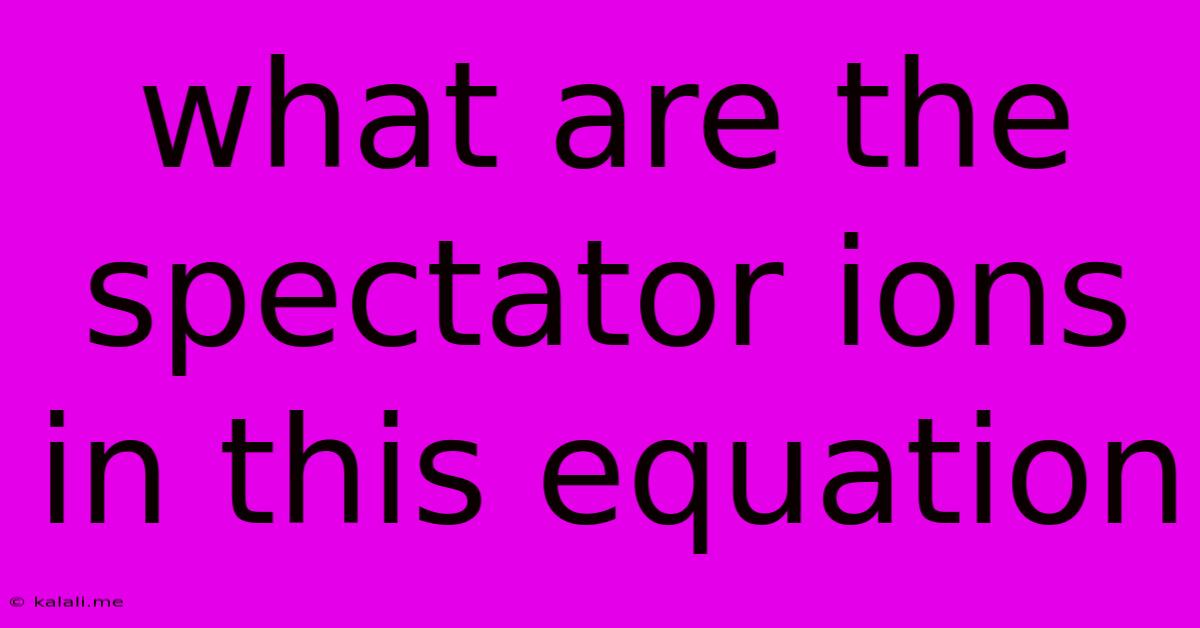What Are The Spectator Ions In This Equation
Kalali
Jun 14, 2025 · 3 min read

Table of Contents
Identifying Spectator Ions: A Comprehensive Guide
This article will guide you through the process of identifying spectator ions in a chemical equation. Understanding spectator ions is crucial for writing net ionic equations, a simplified representation of chemical reactions focusing only on the species directly involved in the change. We'll explore the concept, provide a step-by-step method, and work through some examples.
What are Spectator Ions?
Spectator ions are ions present in a chemical reaction that do not participate in the reaction itself. They remain unchanged throughout the reaction and appear on both the reactant and product sides of the complete ionic equation. They are essentially "watching" the reaction unfold without actively taking part. Identifying them allows us to simplify the equation and focus on the core chemical process.
Identifying Spectator Ions: A Step-by-Step Approach
To identify spectator ions, follow these steps:
-
Write the balanced molecular equation: This is the standard chemical equation showing the reactants and products as complete neutral compounds.
-
Write the complete ionic equation: Break down all soluble strong electrolytes (acids, bases, and salts) into their constituent ions. Insoluble compounds, weak electrolytes, and non-electrolytes remain as molecules.
-
Identify the ions that appear unchanged on both sides of the equation: These are your spectator ions. They are present in the same form and quantity on both the reactant and product sides.
-
Write the net ionic equation: Remove the spectator ions from the complete ionic equation. The remaining ions represent the species that actually react.
Examples
Let's illustrate this with a few examples:
Example 1: Reaction between silver nitrate and sodium chloride
-
Balanced Molecular Equation: AgNO₃(aq) + NaCl(aq) → AgCl(s) + NaNO₃(aq)
-
Complete Ionic Equation: Ag⁺(aq) + NO₃⁻(aq) + Na⁺(aq) + Cl⁻(aq) → AgCl(s) + Na⁺(aq) + NO₃⁻(aq)
-
Spectator Ions: Na⁺(aq) and NO₃⁻(aq) are spectator ions because they appear unchanged on both sides.
-
Net Ionic Equation: Ag⁺(aq) + Cl⁻(aq) → AgCl(s)
Example 2: Reaction between hydrochloric acid and sodium hydroxide
-
Balanced Molecular Equation: HCl(aq) + NaOH(aq) → NaCl(aq) + H₂O(l)
-
Complete Ionic Equation: H⁺(aq) + Cl⁻(aq) + Na⁺(aq) + OH⁻(aq) → Na⁺(aq) + Cl⁻(aq) + H₂O(l)
-
Spectator Ions: Na⁺(aq) and Cl⁻(aq) are spectator ions.
-
Net Ionic Equation: H⁺(aq) + OH⁻(aq) → H₂O(l)
Example 3: A More Complex Reaction
Reactions can involve more than one set of spectator ions. Understanding the process is key to correctly identifying them, even in more complex scenarios. Practice is crucial to mastering this skill.
Conclusion
Identifying spectator ions is a fundamental skill in chemistry, essential for understanding and simplifying chemical reactions. By following the steps outlined above and practicing with various examples, you can confidently determine the spectator ions in any given chemical equation and ultimately write accurate net ionic equations. Remember to consider the solubility rules and the nature of the compounds (strong/weak electrolytes, soluble/insoluble) when writing the complete ionic equation. This will ensure accurate identification of the spectator ions.
Latest Posts
Latest Posts
-
The Unit Of Electrical Power Is The
Jun 15, 2025
-
O T T F F S S E
Jun 15, 2025
-
Which Of The Following Sentences Correctly Uses Apostrophes
Jun 15, 2025
-
Who Set Up The First Psychology Lab
Jun 15, 2025
-
Distinguish Between Terminal Bronchioles And Respiratory Bronchioles
Jun 15, 2025
Related Post
Thank you for visiting our website which covers about What Are The Spectator Ions In This Equation . We hope the information provided has been useful to you. Feel free to contact us if you have any questions or need further assistance. See you next time and don't miss to bookmark.